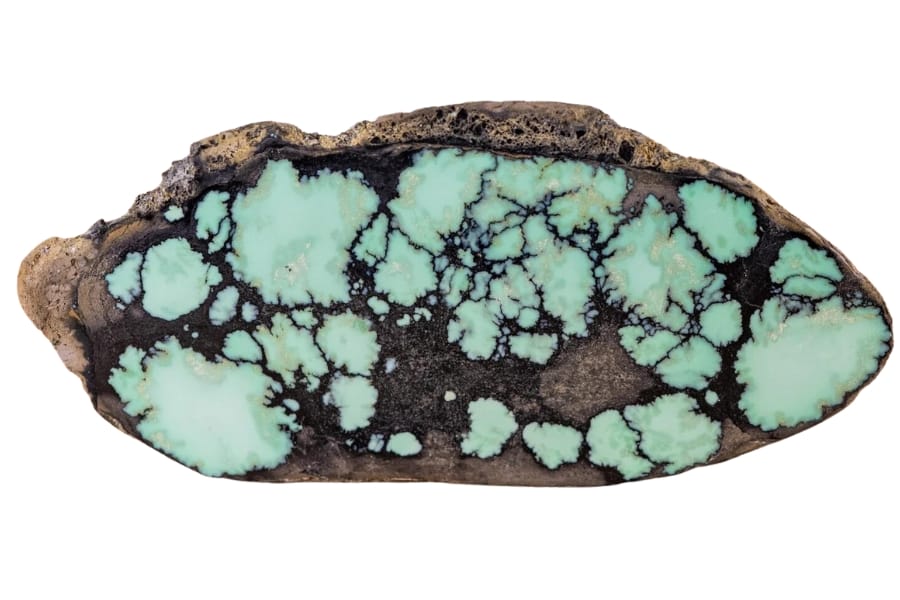Turquoise is a beautiful blue-green stone that has captured the hearts of many. Here in our state, with its diverse landscapes and rich geological history, hunting for turquoise can be an exciting adventure.
This article will guide you to the best spots for finding turquoise in our state and share helpful tips to make your search successful.
So, let’s dive in and explore the best places where you can find Turquoise easily!
How Turquoise Forms Here
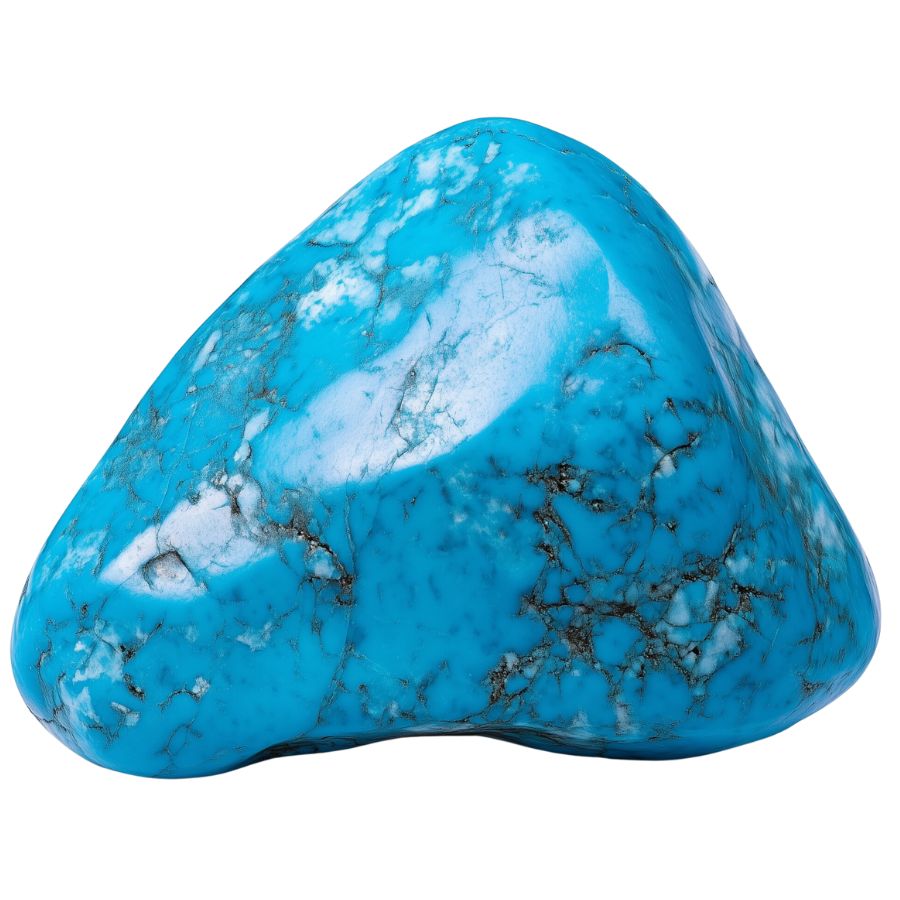
Turquoise forms through a unique process involving water and minerals. It begins when acidic water seeps into the ground, moving through rocks that contain copper and aluminum.
As this water interacts with these minerals, it breaks them down and allows the copper and aluminum to combine with phosphorus, creating turquoise.
This usually happens in shallow areas, often less than 20 meters deep, where the environmental conditions are just right.
This mineral typically fills cracks and cavities in rocks, often in dry, desert-like areas. The presence of iron can also influence its color, giving it beautiful shades of blue and green.
Over time, the turquoise hardens, resulting in the stunning gem we see today, prized for its vibrant hues and unique patterns.
The Types Of Turquoise Found in the US
Turquoise comes in a variety of stunning types, found in the US as well as in our state. Here are the types of turquoise found in the US:
Kingman Turquoise
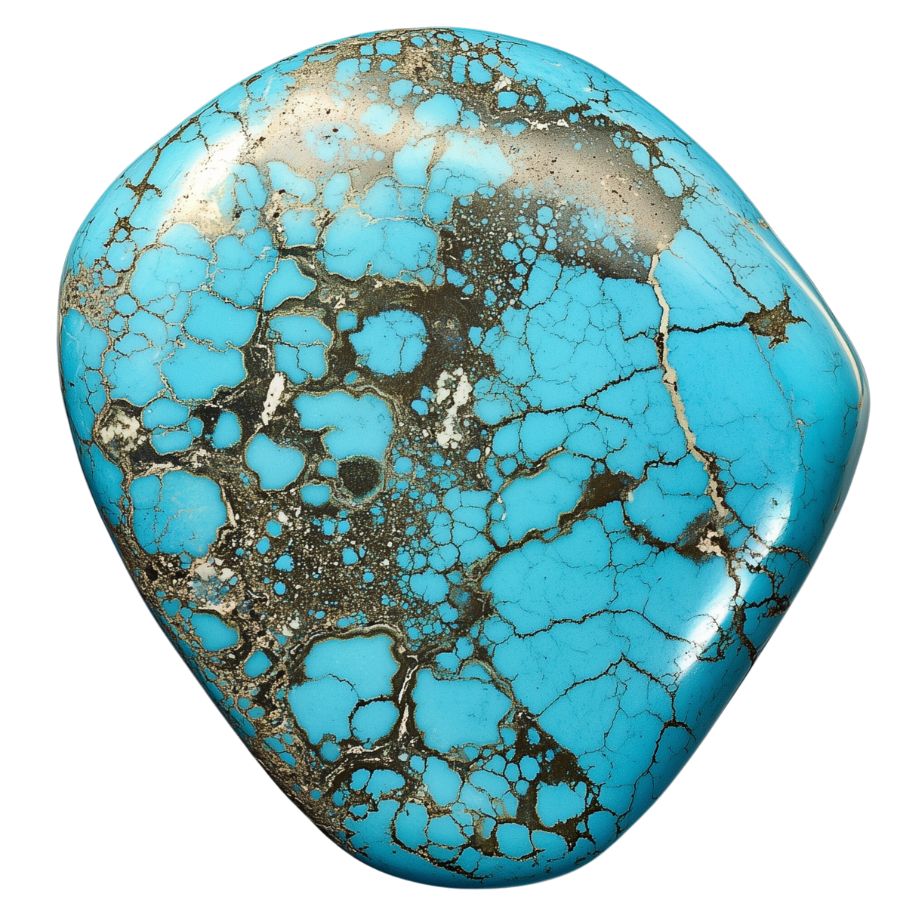
Kingman Turquoise showcases a vibrant range of colors from pale green to deep “high blue.” Its matrix patterns can include white, light brown, or black veining, setting it apart from other turquoise types.
This stone is often stabilized to enhance its durability and color, allowing for broader use in jewelry making. The natural Kingman turquoise typically presents a medium blue hue with a water web matrix.
Kingman Turquoise is recognized as one of the most sought-after American turquoise. Its consistent supply has made it a staple in Native American jewelry and artisan crafts, contributing to its ongoing popularity.
Carico Lake Turquoise
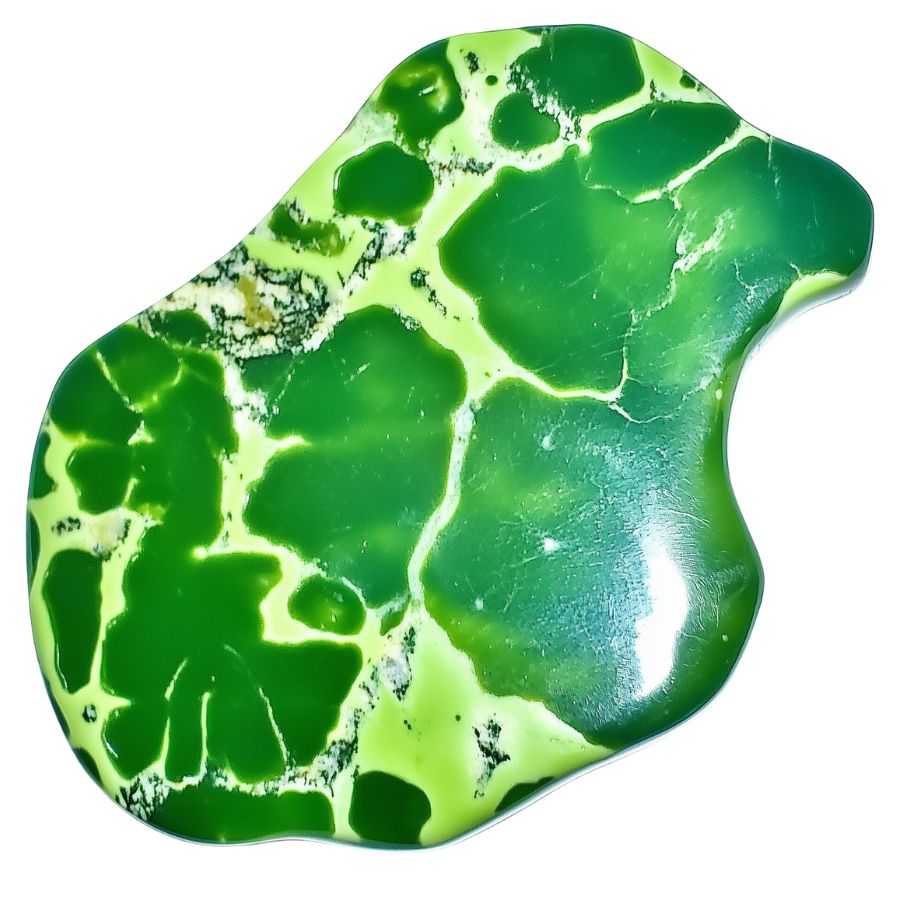
Carico Lake Turquoise is known for its clear robin’s egg blue to vibrant lime green colors. It often features a unique spider-web matrix in brown or, more rarely, black, adding texture and shine to the stone.
What makes this stone special is its high zinc concentration, which gives it an electric lime-green hue. This color is both rare and desirable among turquoise varieties.
Gem-quality Carico Lake Turquoise is scarce, making up less than 3% of the mine’s annual output. This rarity, combined with its natural beauty, makes it a prized item for collectors and enthusiasts alike.
Lone Mountain Turquoise
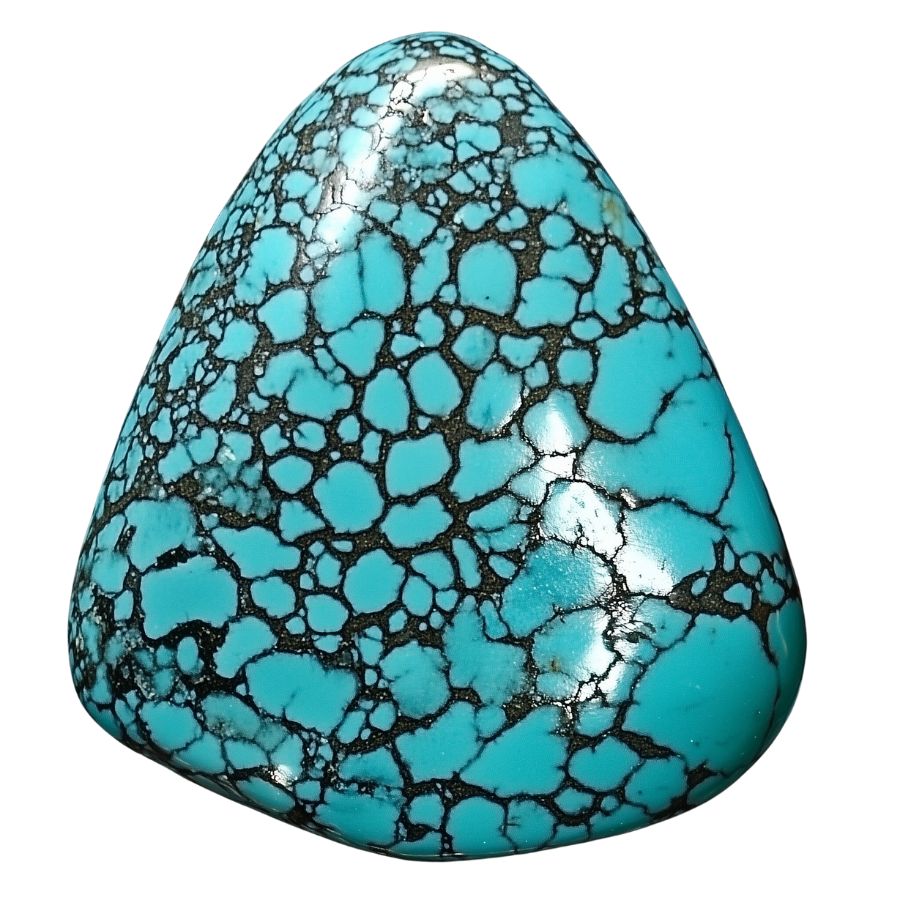
Lone Mountain Turquoise is known for its bright blue to deep green colors, often featuring intricate spider web matrix patterns. These fine lines create a web-like design, enhancing its visual appeal.
This stone stands out for its exceptional hardness and color retention. It maintains its vibrant hue over time, a quality not common in all turquoise varieties.
Lone Mountain Turquoise is highly valued in the collector’s market, second only to Lander Blue Turquoise. Its ability to produce high-quality spider web turquoise makes it a favorite among jewelry artisans and collectors.
Morenci Turquoise
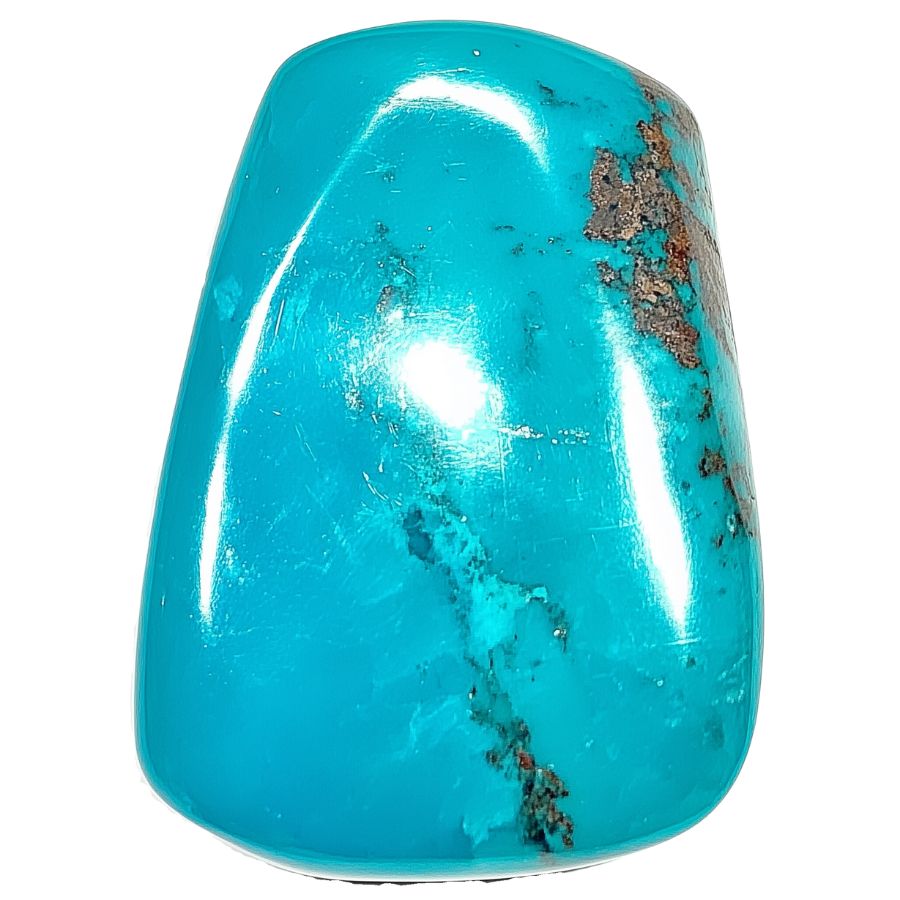
Morenci Turquoise stands out with its deep blue color, a result of its high copper content.
Its most striking feature is the iron pyrite matrix, which gives it a metallic shimmer when polished. Some pieces also show a water web matrix, creating dark blue webbing patterns.
This stone is no longer mined, making it rare and highly collectible. All available Morenci Turquoise comes from mining operations that stopped in 1984.
High-grade pieces, known for vibrant blues and pyrite matrix, make up less than 10% of the total yield.
Pilot Mountain Turquoise
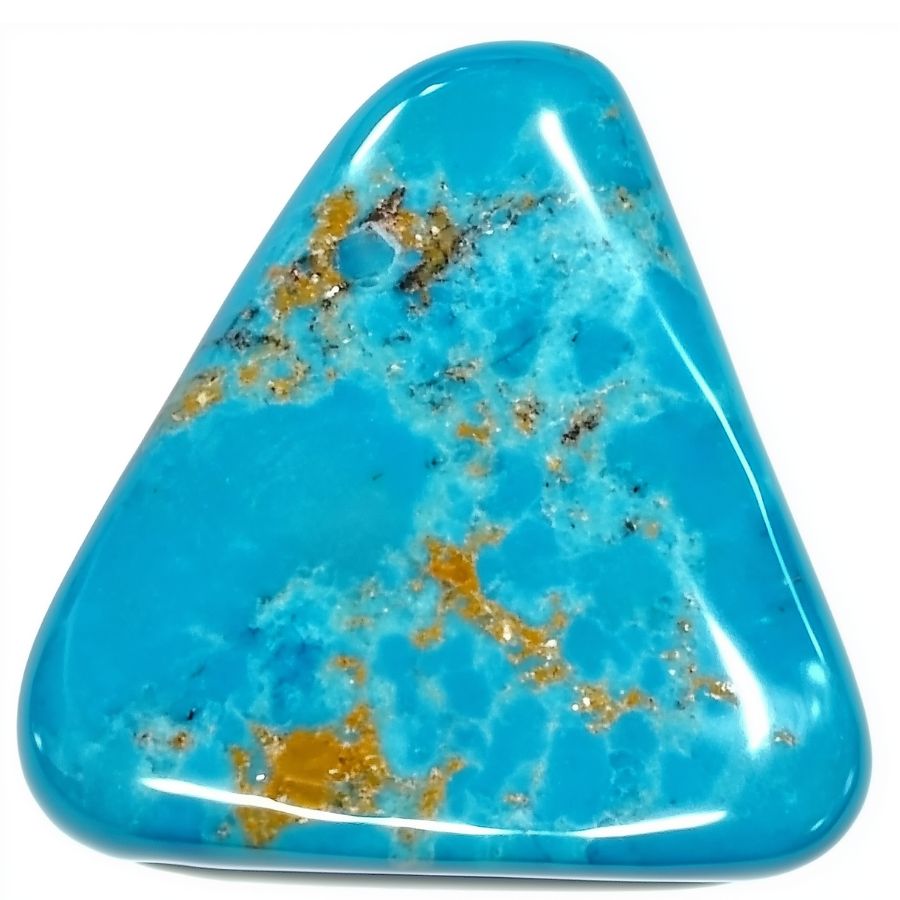
Pilot Mountain Turquoise catches the eye with its bright to dark blue hues, often showing a greenish tint.
What makes it special is its brownish-red limonite matrix, creating beautiful mottled patterns. The stone forms in hard veins, thin seams, or nuggets.
This turquoise has an interesting history, first mined around 1930. It’s known for its limited availability, with only 150 to 200 pounds of rough stone extracted twice a year. This scarcity adds to its appeal.
The unique mottled patterns of the limonite matrix make Pilot Mountain Turquoise a favorite for decorative pieces and jewelry.
Sleeping Beauty Turquoise
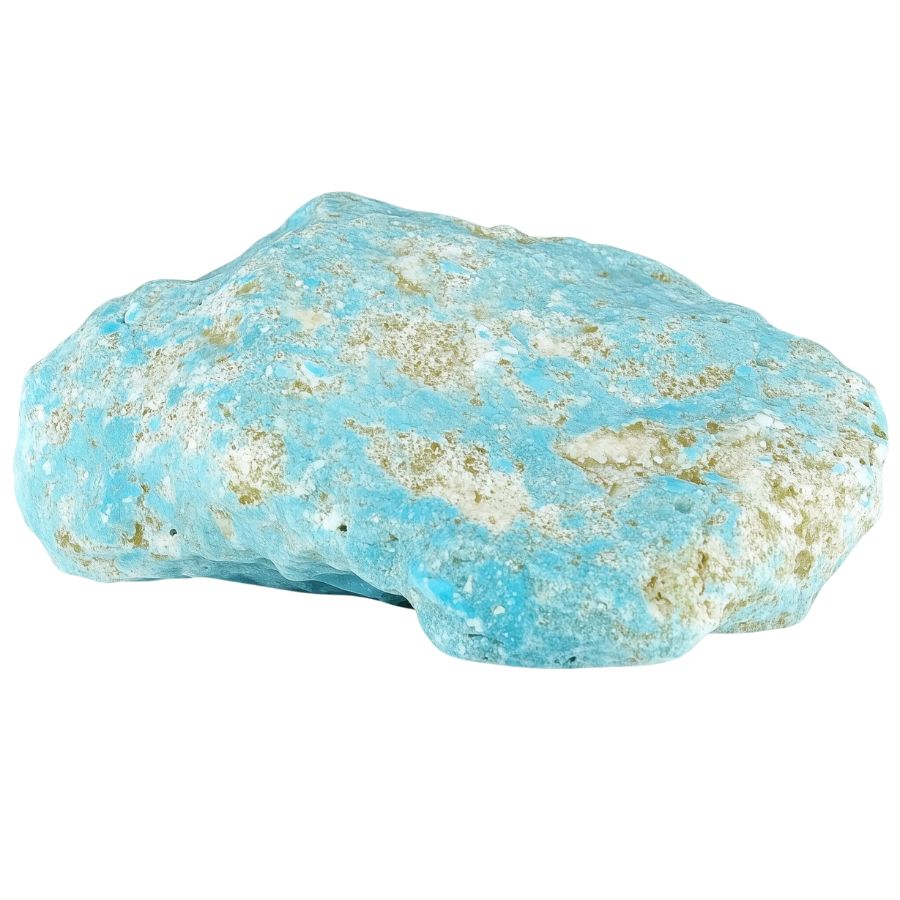
Sleeping Beauty Turquoise is famous for its vivid sky-blue color. Unlike many other turquoise types, it has little to no veining or matrix, giving it a pure, consistent look. The color can range from light robin’s egg blue to deeper sky blue.
This stone is naturally hard, which means it doesn’t need stabilization for use in jewelry. This quality makes it popular with jewelers. The Sleeping Beauty mine closed in 2012, making the stone rarer and more valuable.
Sleeping Beauty Turquoise became a hit in the 1970s and 80s, used in both Native American jewelry and mainstream fashion. Its consistent quality and vibrant color have made it a standard in Southwestern jewelry.
Bisbee Turquoise
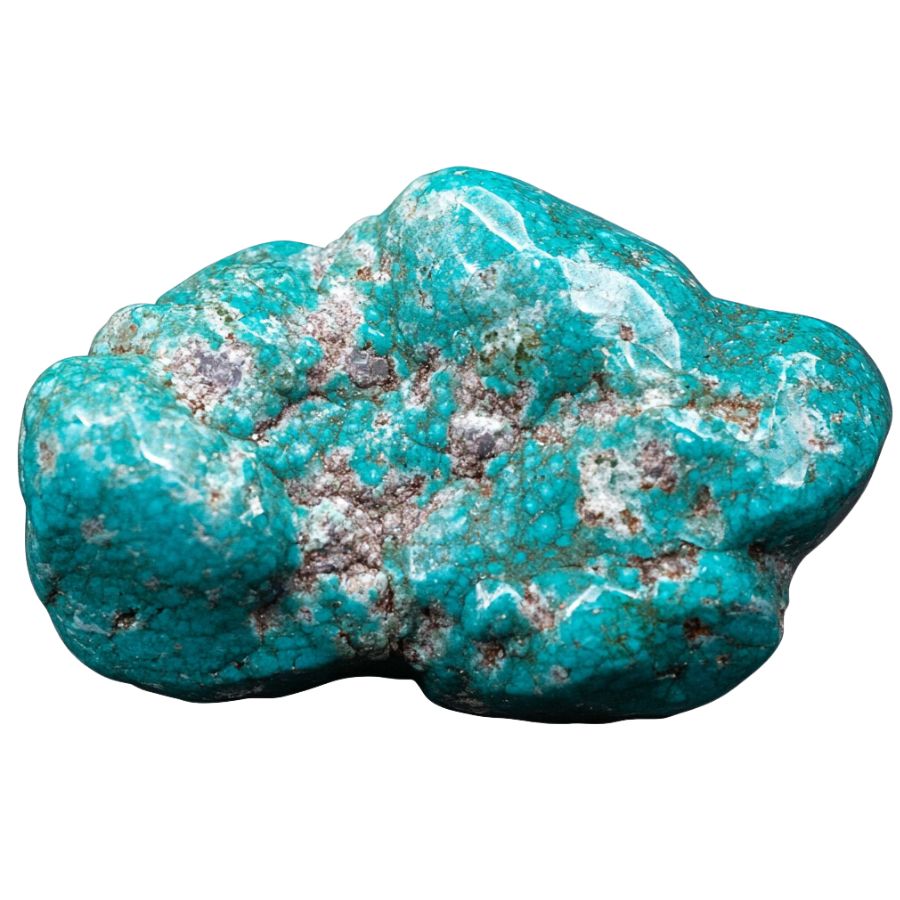
Bisbee Turquoise stands out with its vibrant blue shades, ranging from deep indigo to light robin’s egg blue. Green hues are less common but still occur.
Its distinctive matrix often displays a striking spiderweb pattern against a reddish-brown backdrop.
This stone’s unique appearance comes from its host rock color and gloss. Unlike some turquoise with metallic matrices, Bisbee’s matrix is typically more earthy and varied in color.
Bisbee Turquoise is highly valued for its quality and rarity. Its historical significance, being one of the oldest turquoise sources in North America, adds to its appeal among collectors and enthusiasts.
Royston Turquoise
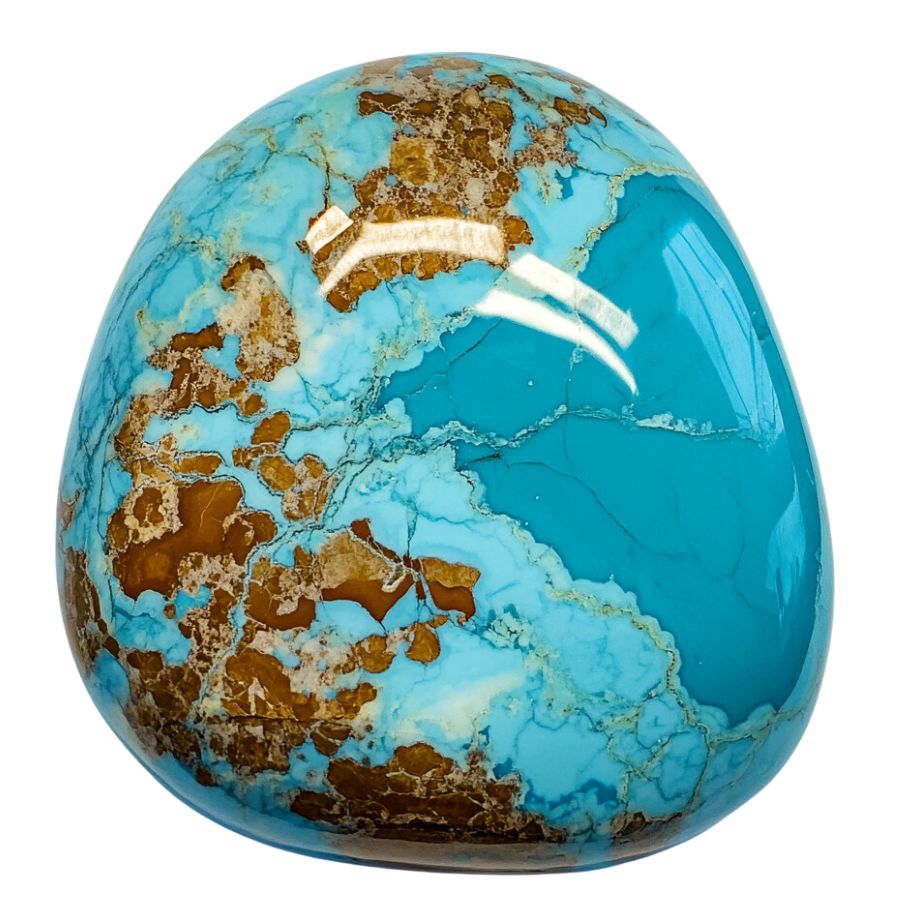
Royston Turquoise is a gem of many faces. Its colors can shift dramatically, even within a single stone.
You might find a piece that starts as a soft blue and gradually transforms into a rich green. This color play is a hallmark of Royston Turquoise.
The stone’s matrix is equally fascinating. The matrix can create intricate landscapes within the turquoise, resembling golden sunsets or stormy skies.
Royston Turquoise is also known for its ability to take an exceptionally high polish. This quality, combined with its natural hardness, makes it a favorite for jewelry that can withstand daily wear.
Dry Creek Turquoise
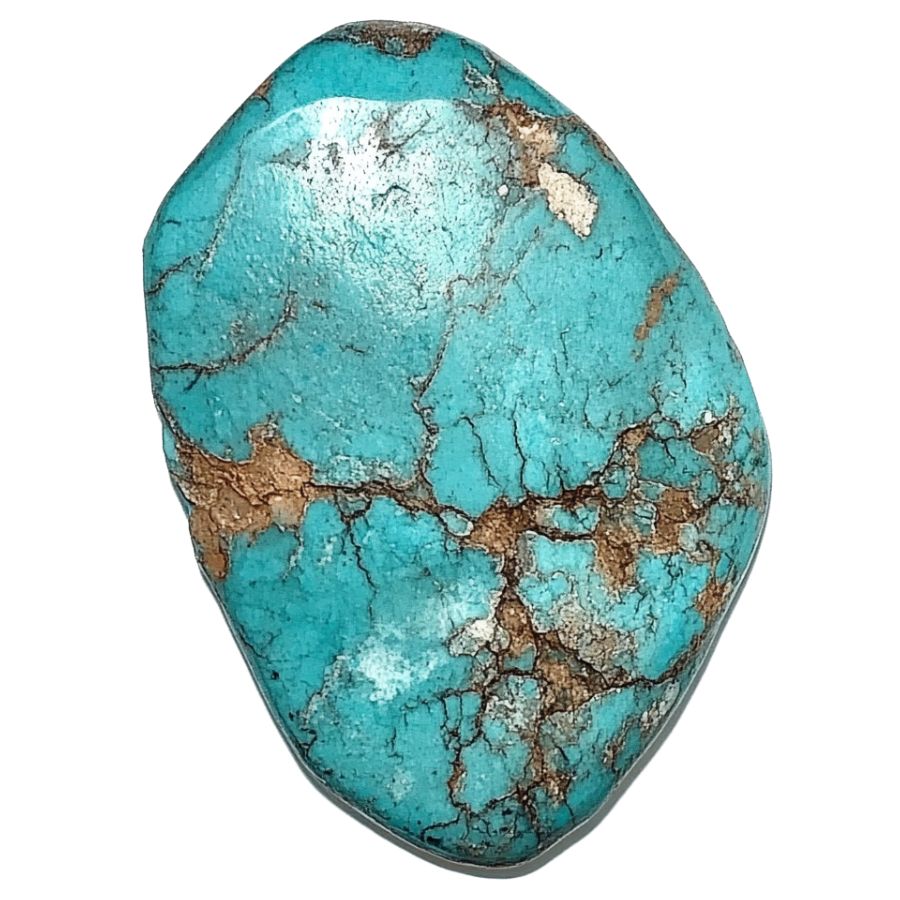
Dry Creek Turquoise stands out with its pale pastel blue color, similar to Larimar. It often has light brown, golden yellow, or orange webbed matrices, adding to its beauty.
Unlike many turquoise types, it’s naturally hard and takes a stunning polish without treatment.
This stone is quite rare. It was discovered in the 1990s in an area with low levels of heavy metals. These metals usually give turquoise its bright colors. The unique geological setting results in Dry Creek’s captivating pale blue hue.
The natural hardness and ability to take a high polish make Dry Creek Turquoise special.
Ithaca Peak Turquoise
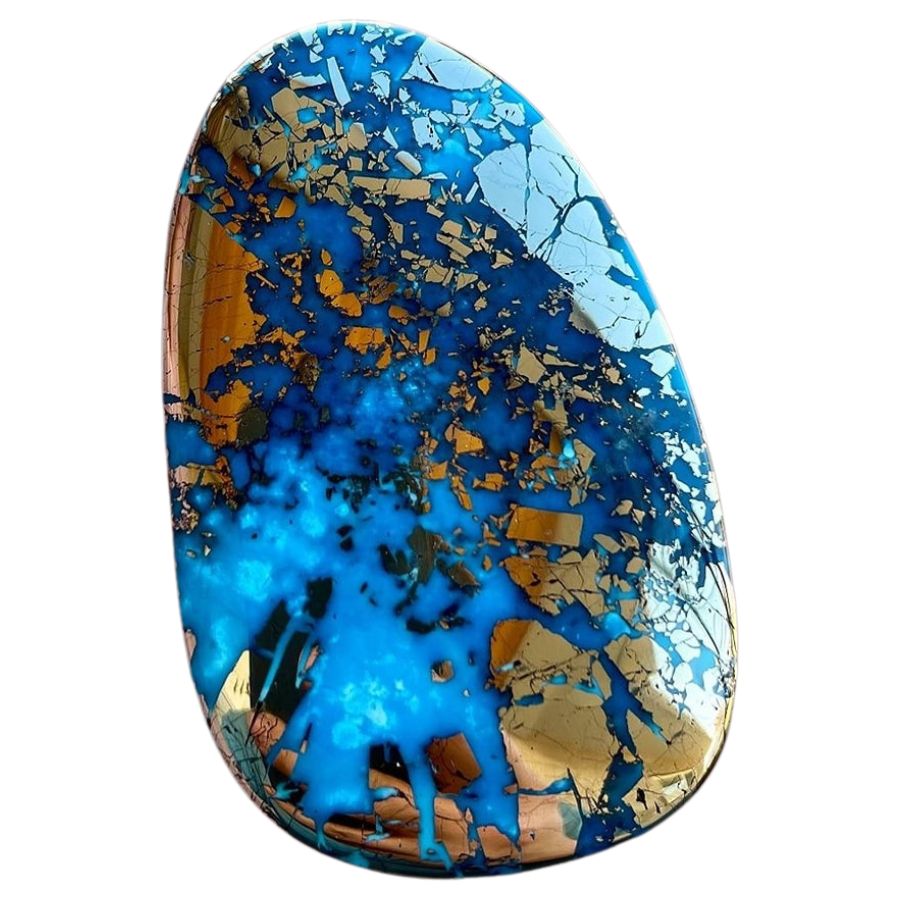
Ithaca Peak Turquoise is known for its stunning range of blues. It can be light blue with black spider-webbing or deep rich blue with black matrix.
Some pieces even have quartz matrix and pyrite inclusions. The most valued stones have vibrant to dark blues with good pyrite inclusions.
What makes this stone unique is its pyrite. In Ithaca Peak Turquoise, the pyrite often has a brassy color. This helps tell it apart from similar stones like Morenci turquoise.
Recently mined Ithaca Peak Turquoise looks different from older pieces. The new stones are lighter blue to green and usually don’t have a webbed matrix. This change in appearance over time adds to the stone’s interesting history.
What Raw Turquoise Looks Like
When you’re going to collect the raw turquoise, it’s important to know what to look for. Let’s talk about how you can identify genuine raw turquoise.
You only need to know a few things in order to find it, but having a guide will be very helpful.
DON'T MISS OUT ON ANY GREAT FINDS!
While you're out searching for Turquoise you're going to find A LOT of other interesting rocks and minerals along the way. The last thing you want to do is toss out something really interesting or valuable. It can be easy to misidentify things without a little guidance.
You absolutely need a good reference guide in order to understand what you're looking at!
We've put together a fantastic field guide that makes identifying 140 of the most interesting and valuable rocks and minerals you will find REALLY EASY. It's simple to use, really durable, and will allow you to identify just about any rock and mineral you come across. Make sure you bring it along on your hunt!
Now, back to the identification specifics:
Look for the Blue-Green Color
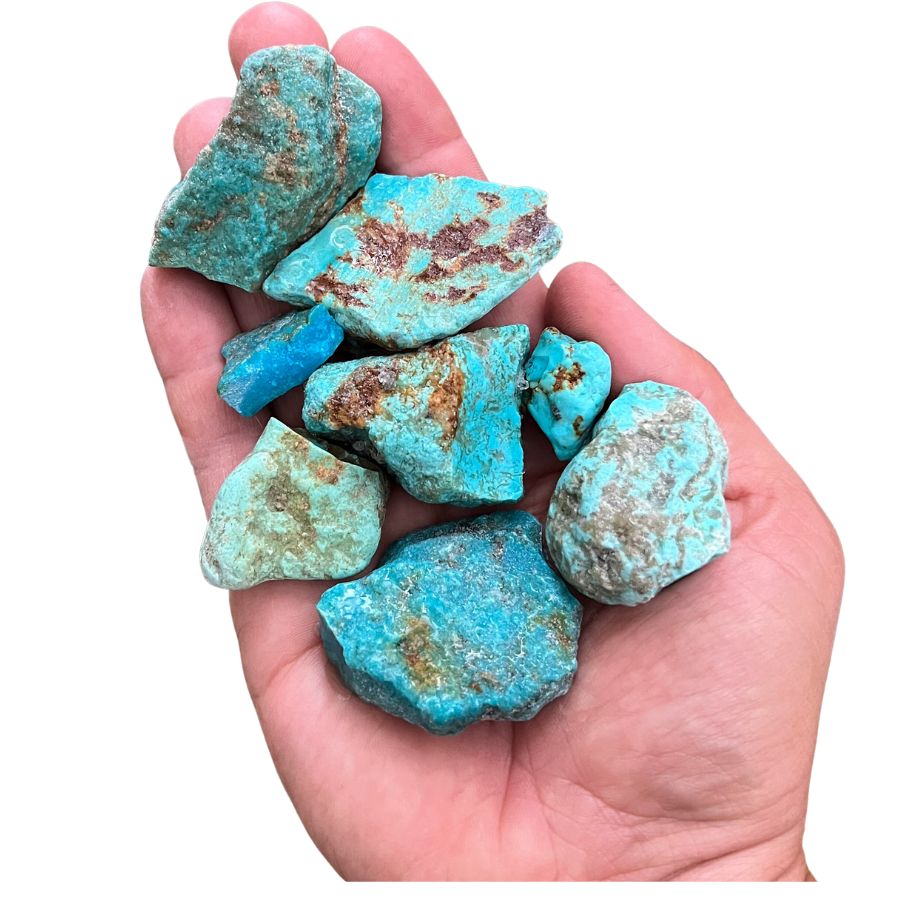
The color is the big clue. Rough turquoise is often blue or green, sometimes with hints of both.
The blue comes from copper, while the green hints at more iron or other minerals.
Real turquoise tends to have a more vibrant, consistent color. If it looks too perfect, like solid blue or green with no variations, be cautious. Nature isn’t that perfect!
Assess the Density and Weight
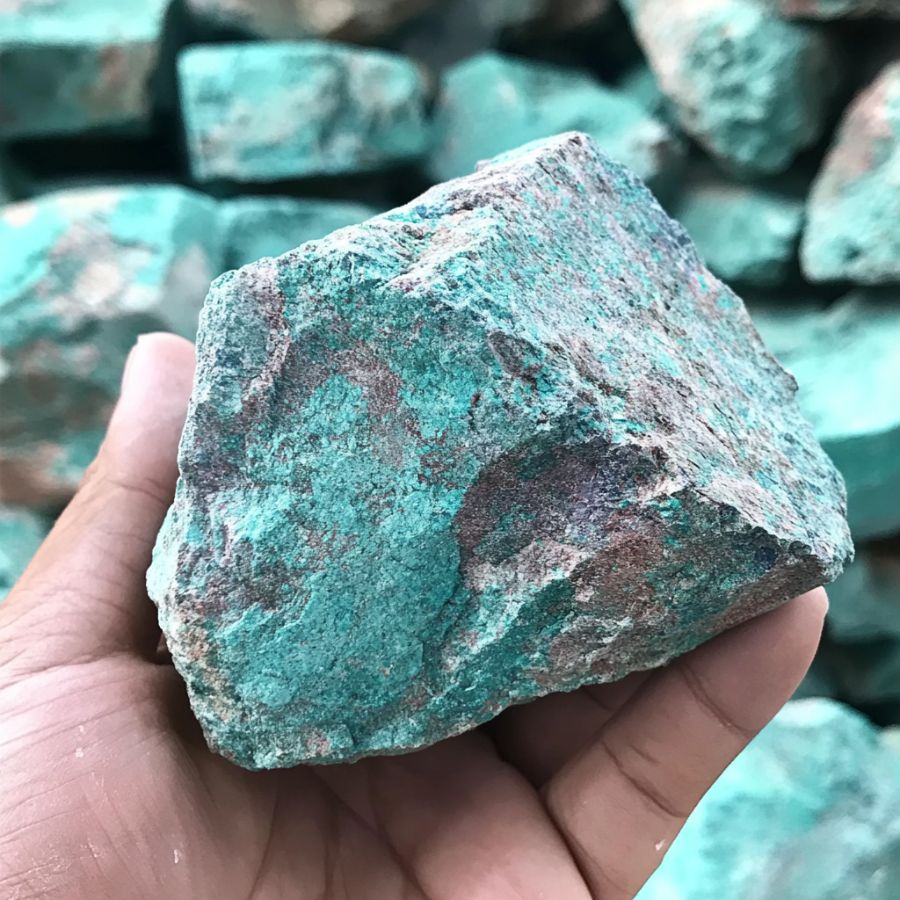
Pick up the stone and feel its weight. Real turquoise is pretty dense, so it feels heavier than it looks. If the stone feels too light, it might not be genuine.
Authentic turquoise has a specific gravity of about 2.5 to 2.9, making it heavier than many imitations.
The density comes from the minerals packed tightly together over millions of years. A heavier stone usually means a better-quality piece.
Check for a Glassy or Waxy Luster
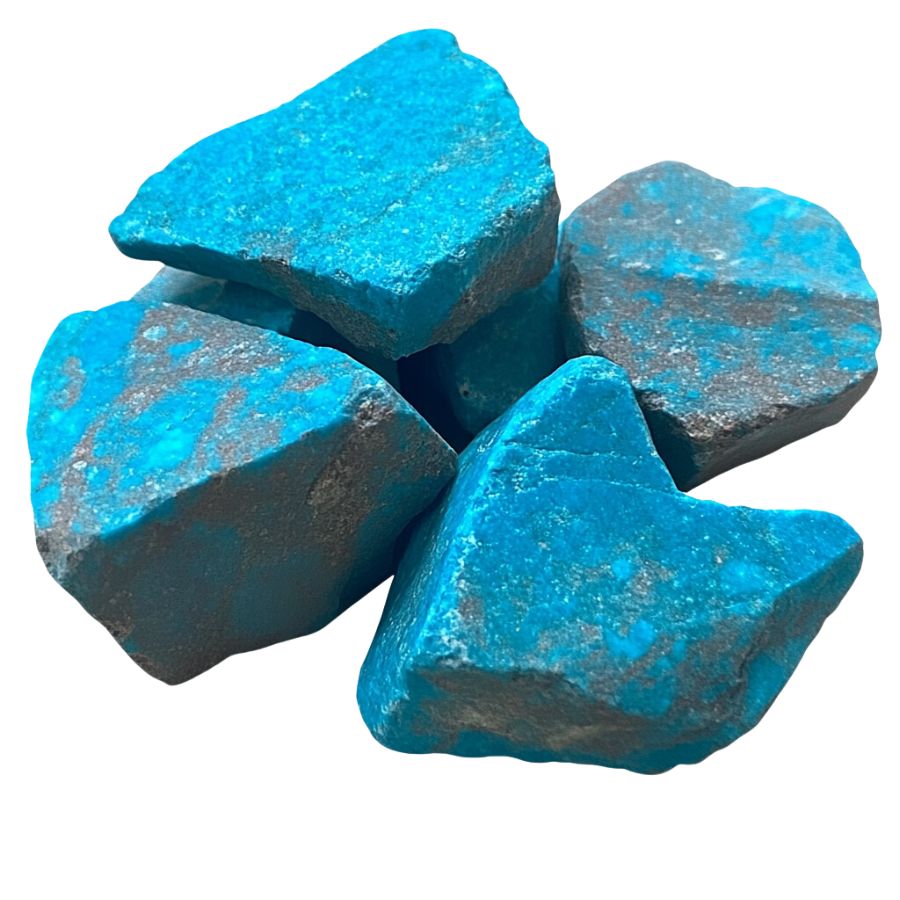
Rough turquoise often has a glassy or waxy luster, not too shiny but not dull either. When you hold it up to the light, the surface might have a soft, smooth sheen. This luster is key.
A rough piece with a good luster usually indicates that it’s real turquoise and not a fake. You’ll notice that it reflects light in a muted way, not too bright.
Consider the Stone’s Shape and Texture
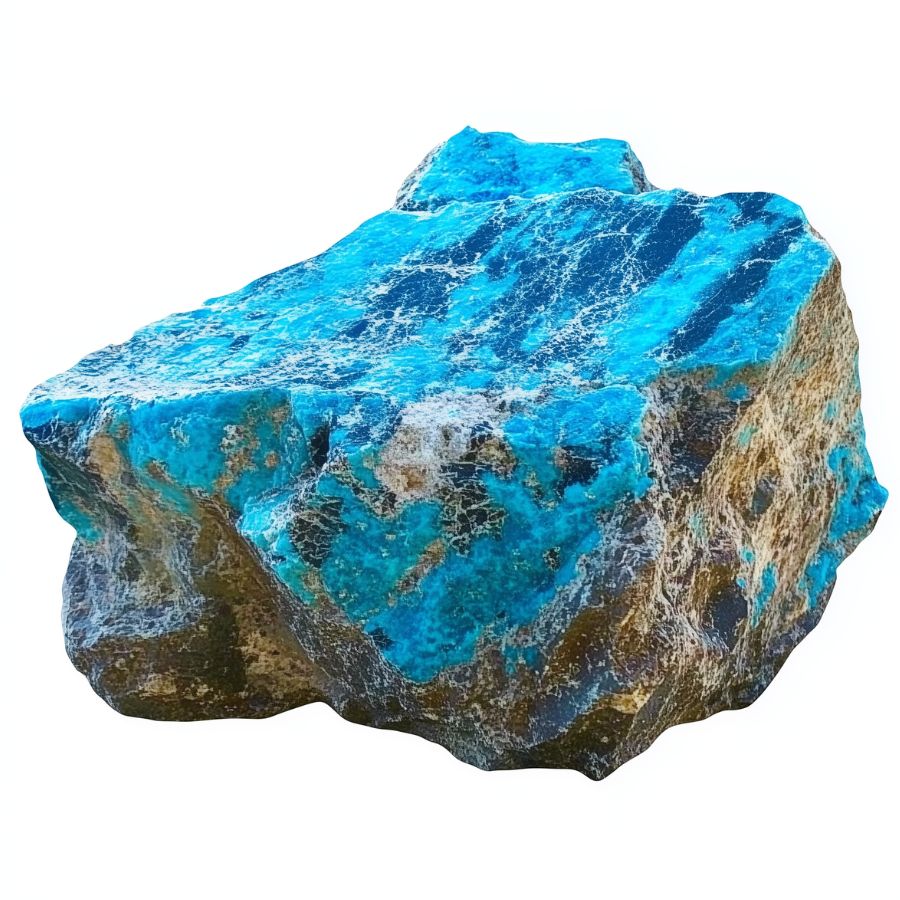
Rough turquoise isn’t always smooth. It often has a bumpy, uneven texture because it forms in cracks and crevices of other rocks.
The stone’s shape might be irregular or lumpy. This natural texture is a telltale sign that you’re holding real turquoise and not a polished or treated piece.
A Quick Request About Collecting
Always Confirm Access and Collection Rules!
Before heading out to any of the locations on our list you need to confirm access requirements and collection rules for both public and private locations directly with the location. We haven’t personally verified every location and the access requirements and collection rules often change without notice.
Many of the locations we mention will not allow collecting but are still great places for those who love to find beautiful rocks and minerals in the wild without keeping them. We also can’t guarantee you will find anything in these locations since they are constantly changing.
Always get updated information directly from the source ahead of time to ensure responsible rockhounding. If you want even more current options it’s always a good idea to contact local rock and mineral clubs and groups
Tips on where to look
Once you get to the places we have listed below there are some things you should keep in mind when you’re searching:
Riverbeds
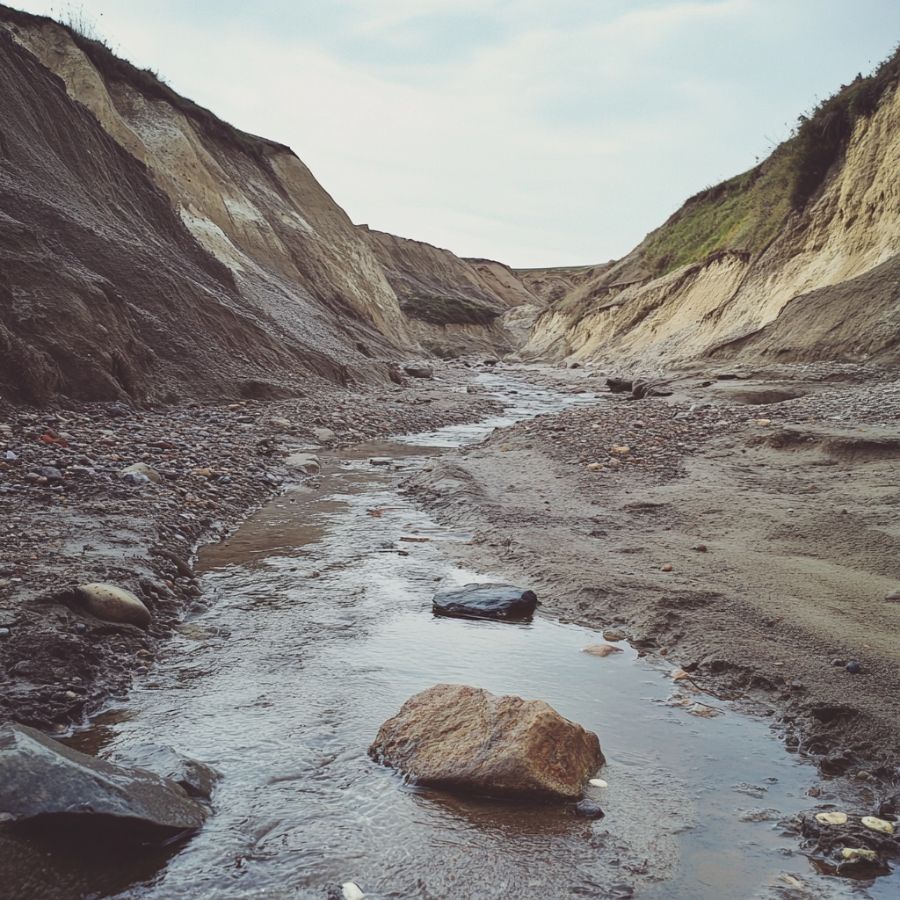
Look for turquoise in riverbeds. Over time, water flow can expose hidden stones.
Sediment may hold the gems you’re after. Be prepared to dig through gravel and dirt to find them.
Abandoned Mines
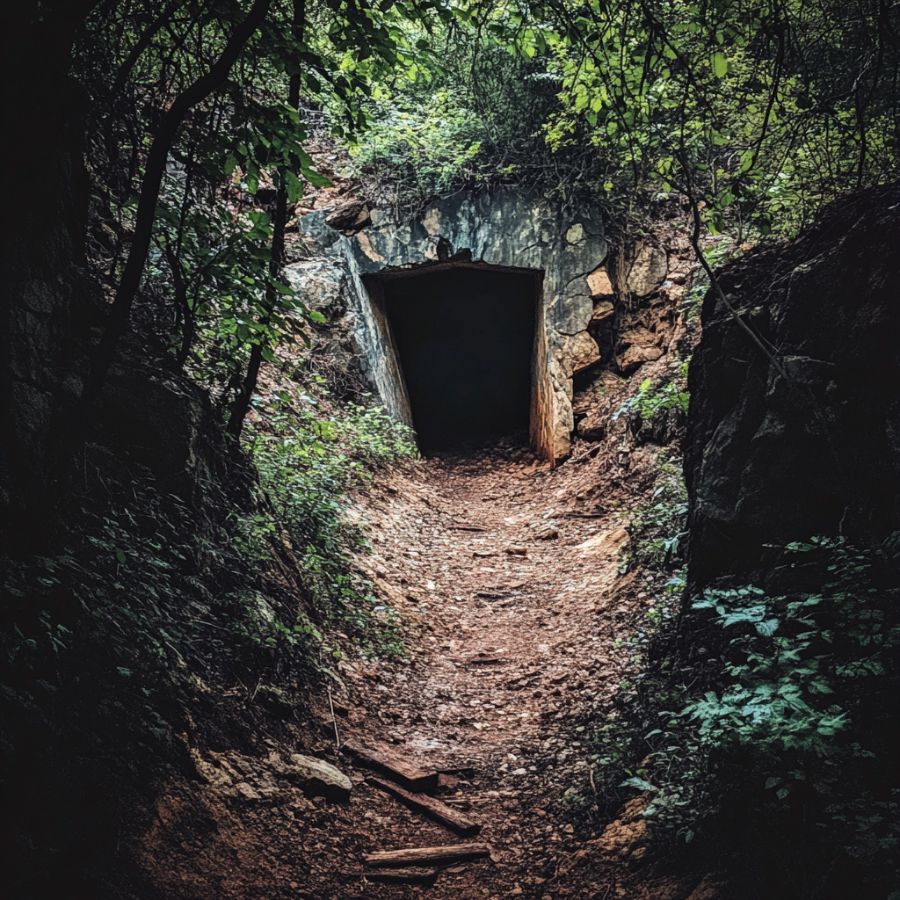
Old mines can be treasure troves for turquoise. These sites often have loose rocks where turquoise might be hiding.
Always be careful while exploring abandoned areas, though.
Hillsides
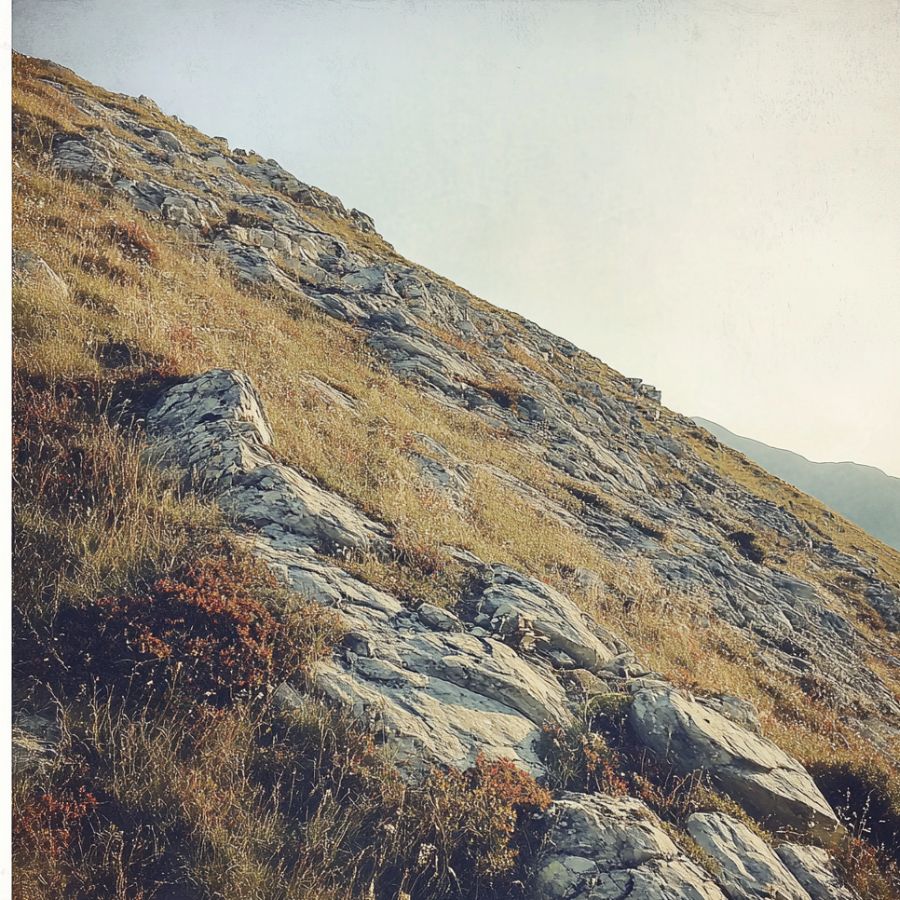
Check hillsides, especially where erosion is visible. Rain and wind can uncover layers of earth, exposing turquoise.
It’s a bit of a hunt, but it can be rewarding. Sometimes, you’ll find small stones just lying on the surface.
Rocky Outcrops
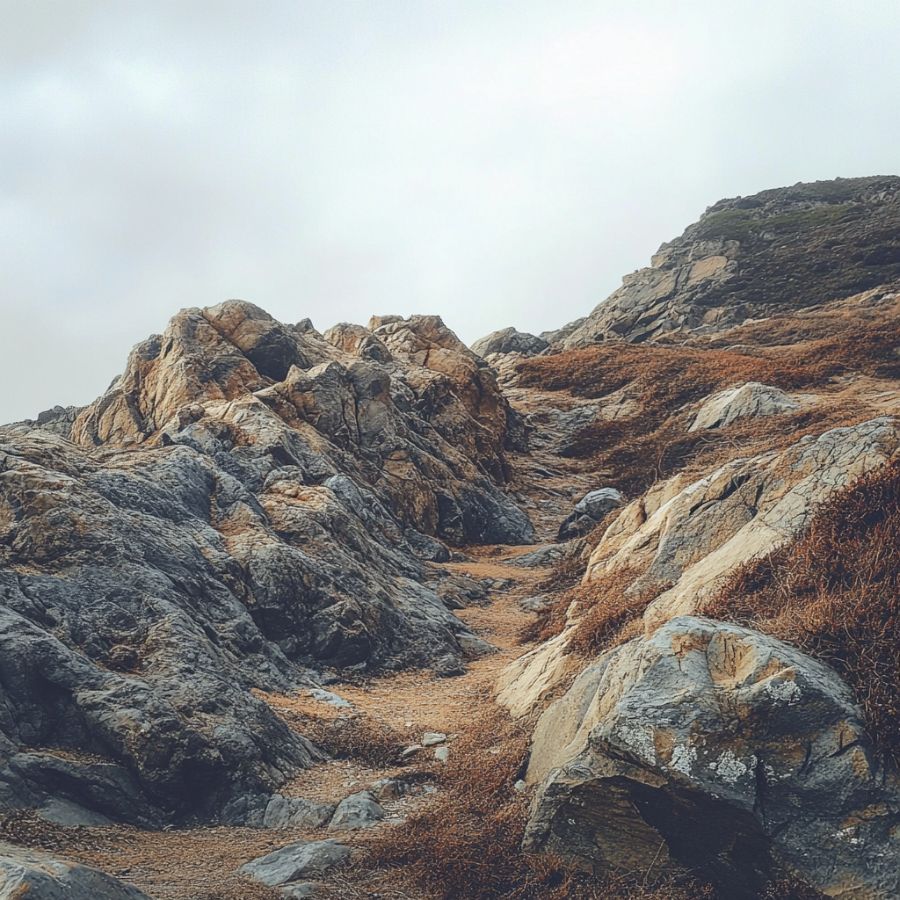
Rocky outcrops are great places to search. They are full of minerals and might have turquoise.
Explore the cracks and crevices. Turquoise often hides in these tight spaces.
The Types Of Turquoise Found In Texas
It’s interesting to see how different the minerals in Texas are when you look at turquoise. It comes in many colors, has different qualities, and has different names. These are the types of turquoise you’ll come across in the state:
- Blue-green turquoise
- Green turquoise
- Spiderweb turquoise
The Best Places To Find Turquoise in Texas
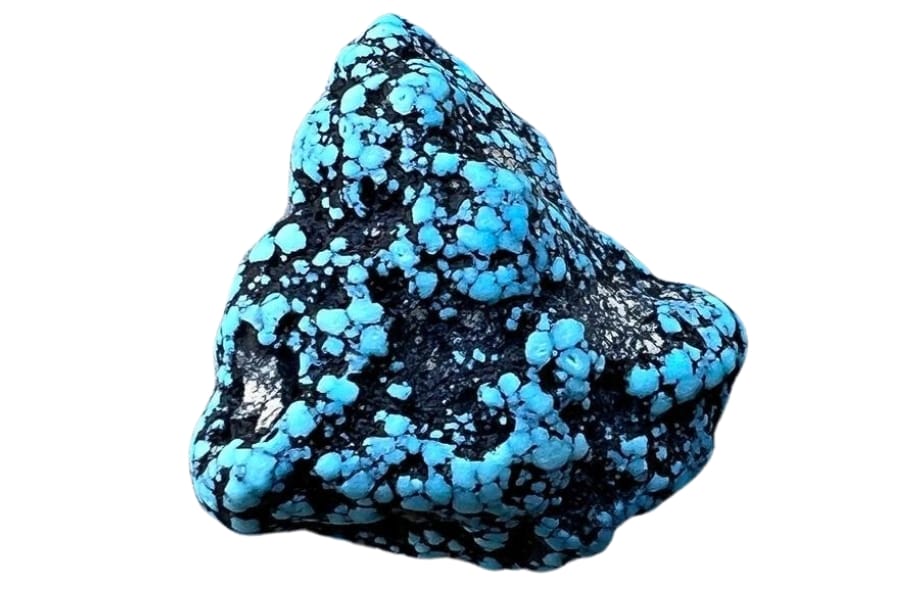
Let’s talk about the best places in the state to find turquoise. There are many great places to mine for gems in Texas, but only a few are good for finding turquoise. Not many people know about some of these places, but they often have great chances to search.
Always Confirm Access and Collection Rules!
Before heading out to any of the locations on our list you need to confirm access requirements and collection rules for both public and private locations directly with the location. We haven’t personally verified every location and the access requirements and collection rules often change without notice.
Many of the locations we mention will not allow collecting but are still great places for those who love to find beautiful rocks and minerals in the wild without keeping them. We also can’t guarantee you will find anything in these locations since they are constantly changing.
Always get updated information directly from the source ahead of time to ensure responsible rockhounding. If you want even more current options it’s always a good idea to contact local rock and mineral clubs and groups
Carrizo Mountains
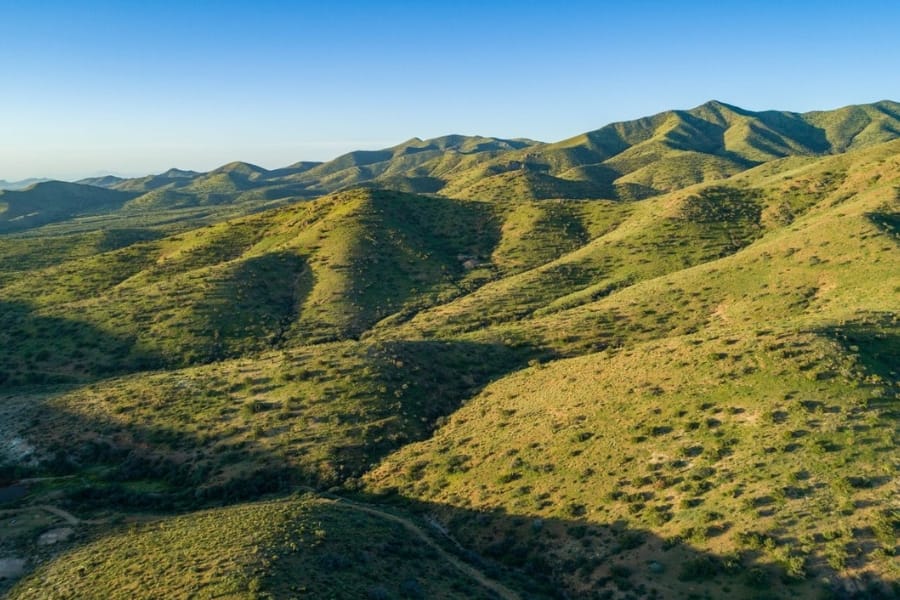
The Carrizo Mountains are a beautiful range that not many people know about. They are hidden in the vast landscapes of West Texas. Geology fans will enjoy these mountains because they have a unique mix of rocks and minerals.
Over the years, different geological events have left this area with a lot of minerals, such as turquoise, a beautiful blue-green stone.
There is a mix of copper, aluminum, and water in the mountains, which are all necessary for turquoise to form. Over millions of years, the gem was formed slowly as rainwater moved through the rocks and mixed with these elements.
Along with the chance to find turquoise, the mountains offer stunning views and a taste of nature that hasn’t been changed in any way. In other words, the Carrizo Mountains are a great place to start if you want to find turquoise or see how beautiful Texas’s rough terrain is.
Before you bring anything home from Texas, make sure you know the most up-to-date rules for collecting.
Where we found turquoise in the Carrizo Mountains
A lot of rock and gem hunters go to areas in the Carrizo Mountains that are known to be mineral-rich to look for turquoise and other gems. If you want to find turquoise, you should look for places that are dry and have geological features like water reacting with minerals like copper.
DON'T MISS OUT ON ANY GREAT FINDS!
While you're out searching for Geodes you're going to find a lot of other interesting rocks and minerals along the way. The last thing you want to do is toss out something really interesting or valuable. It can be easy to misidentify things without a little guidance.
We've put together a fantastic field guide that makes identifying 140 of the most interesting and valuable rocks and minerals you will find REALLY EASY. It's simple to use, really durable, and will allow you to identify just about any rock and mineral you come across. Make sure you bring it along on your hunt!
Guadalupe Mountains
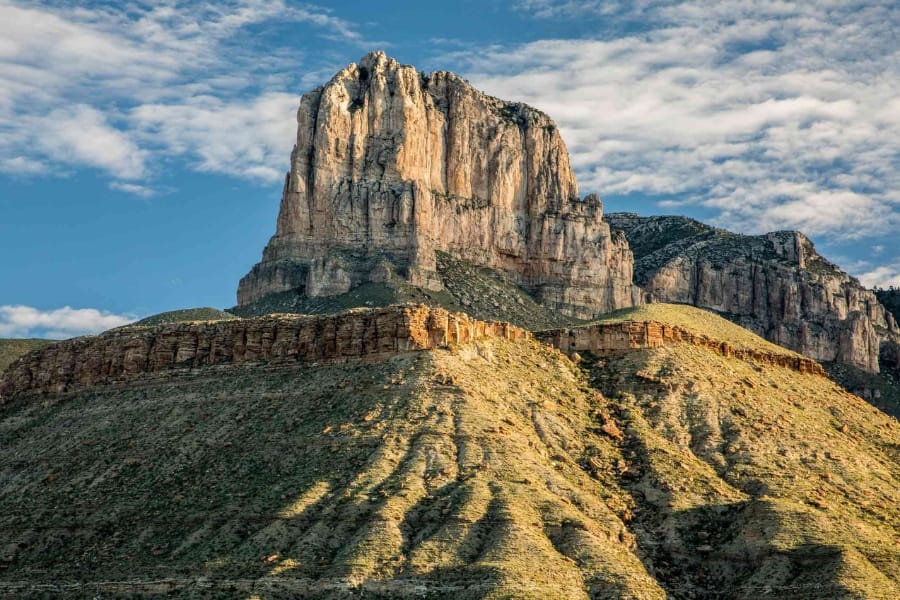
The Guadalupe Mountains are very tall and give people a look into the state’s amazing geological history. This mountain range in West Texas is famous for more than just its hiking trails and state’s tallest peak.
It’s also a mineral treasure trove. One of these treasures is turquoise, a beautiful blue-green stone.
The conditions here were perfect a long time ago for turquoise to form. Copper, along with other elements and rainwater, made pockets of this valuable gem inside the rocks.
Over the years, erosion and natural forces have brought some of these turquoise deposits to the surface. People who like exploring and rocks often come to this area to try to see or even find a piece of this beautiful stone.
The Guadalupe Mountains are a great location for both adventurers and people looking for gems because they contain turquoise as well as beautiful natural sights.
Where we found turquoise in the Guadalupe Mountains
Outside of protected areas, you may explore other parts of the Guadalupe Mountains. Given its geology, it’s possible to find turquoise in specific locales, especially where there’s evidence of copper mineralization.
Plata Verde Mine
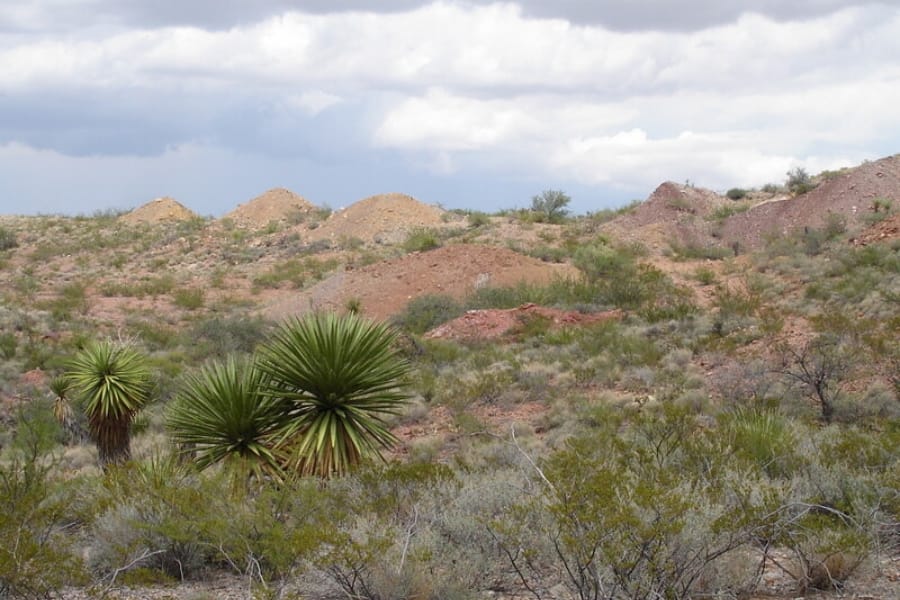
People who love the beauty of turquoise will love the Plata Verde Mine. This mine, which is in the middle of the state’s vast landscapes, is famous for its fine turquoise gems.
“Plata Verde” means “Green Silver” in Spanish, which is another clue about what it is worth. These mines have been producing turquoise stones for many years. The stones are bright in color and of high quality.
Copper is common in this area, which is what gives turquoise its blue color. Natural elements and rainwater come together to make beautiful turquoise stones.
Miners and collectors widely praise Plata Verde turquoise for its deep color and small matrix, which makes it ideal for crafting and jewelry. That’s why you should check out Plata Verde Mine if you want to find some of the freshest turquoise in Texas!
Where we found turquoise at Plata Verde Mine
The Plata Verde Mine in Texas is famous for its turquoise, making it one of the best places in the state to look for this blue-green gem. If you want to look through the mine for turquoise, you have to know where the copper-rich areas are.
Sierra Blanca Peaks
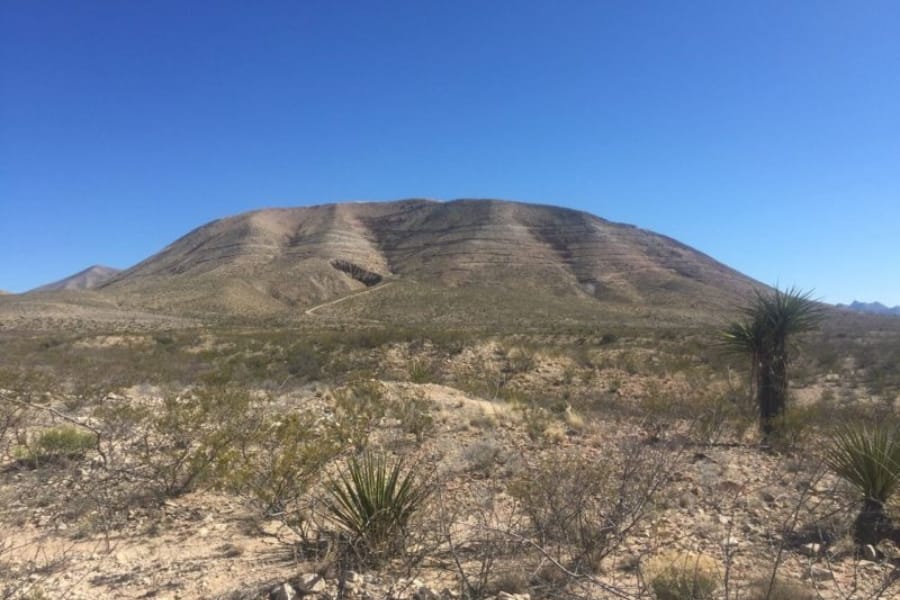
The Sierra Blanca Peaks are more than just a beautiful sight; they’re also a great place to find gems. The peaks in West Texas are full of minerals and have layers upon layers of geological wonders from long ago.
The bright turquoise, a blue-green stone that many people love, is one of the gems that are hidden in these mountains.
Because of the way their rocks are formed, the Sierra Blanca Peaks are the perfect place for turquoise to grow. People who want to find this beautiful gem or learn more about it will be drawn to these mountains.
For that reason, the Sierra Blanca Peaks in Texas are a must-see for anyone who loves finding hidden gems in nature.
Where we found turquoise at Sierra Blanca Peaks
With its mineral-rich makeup, the areas around Sierra Blanca Peaks could be good places to find turquoise. Mountainous regions can be tricky and potentially dangerous. Always have the right equipment, be cautious, and preferably explore in groups.
Sierra Tinaja Pinta
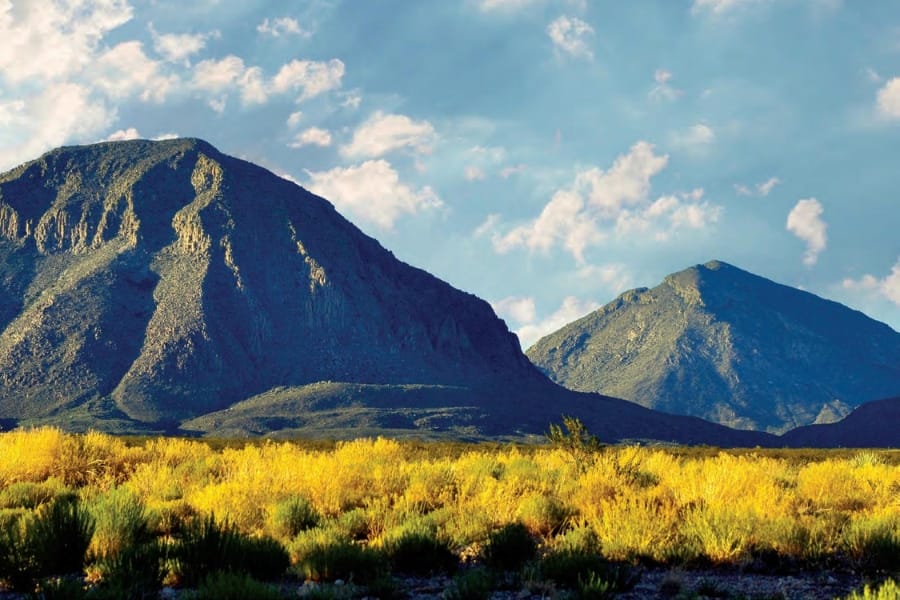
Sierra Tinaja Pinta is a beautiful place that gem lovers love. The unique name comes from the unique geological features of the area: “tinaja” refers to the rocky basins that hold water, and “pinta” means “paint” in Spanish, a reference to the colorful rock formations.
Turquoise is one of the most valuable minerals that can be found in Sierra Tinaja Pinta. Over many years, the right mix of elements, such as copper, and rainwater made it possible for turquoise to form.
It offers a journey full of discoveries and the allure of nature’s treasures to people who like to take risks and look for gems. This place in Texas is worth seeing whether you know a lot about it or are just interested.
Where we found turquoise at Sierra Tinaja Pinta
You can explore its terrain and look for turquoise through its rocky basins and colorful rocks.
Other Great Places To Find Texas Turquoise
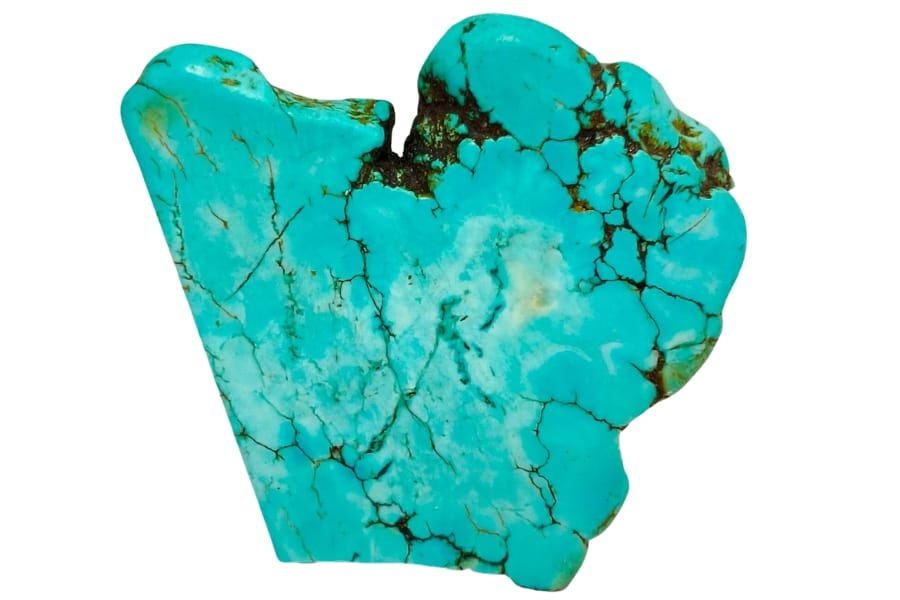
We wanted to talk about the other places on our list after we talked about our favorites. We’ve broken down each suggestion by county and added a few more locations where we’ve had success.
Our recommendations by county
| County | Location |
| Culberson | Van Horn area, slopes of smaller hills |
| Culberson | Nickel Creek |
| Culberson | Maltby Mine |
| Hudspeth | Texas Turquoise Company Mine |
Common Turquoise-Hunting Questions
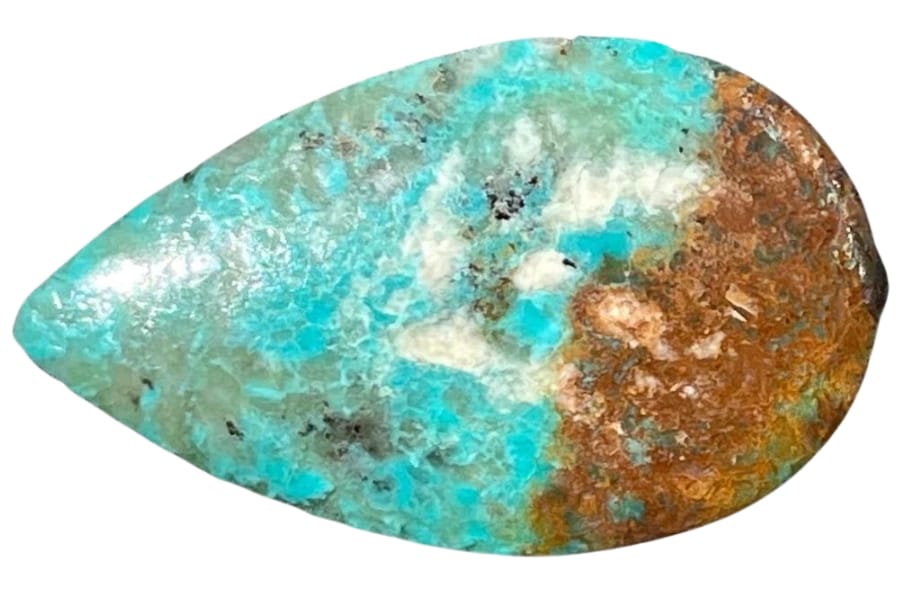
If you want to know where to find turquoise in Texas, here are some questions that people often ask:
Is it illegal to collect turquoise in Texas?
In Texas, as in many other states, it depends on where you are and who owns the land if you can legally collect turquoise or any other mineral.
Get any permissions or permits you may need before you go to Texas to try to collect minerals like turquoise. Learn about the area you want to visit, the laws that apply, and the rules and laws that apply.
To protect natural and cultural resources for future generations, rockhounding must be done in a smart way.
The Best Places To Buy Turquoise In Texas
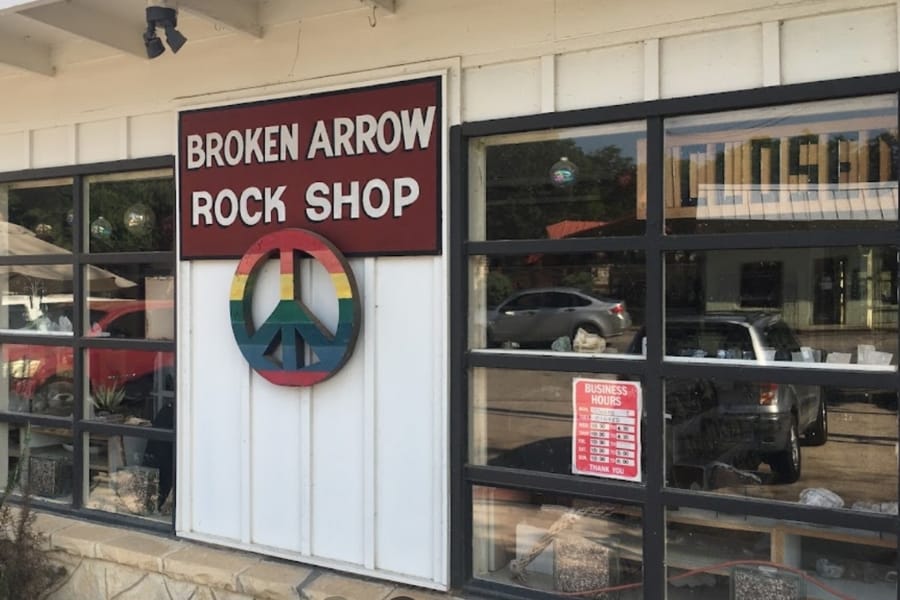
Having turquoise in your hands will always make you feel good if you like it or collect it. But some people don’t like working hard and getting dirty. This list is for you if you want to find turquoise without having to do that.
Here are some of our favorite places to find and buy turquoise in the area:
- Broken Arrow Rock Shop and Gallery – 13904 Ranch Rd 12 #3, Wimberley, TX 78676, United States
- Crystal Rock Shop – 2136 Roy Rd, Tyler, TX 75707, United States
- Geno’s Mine Rock Shop – 6062 Holly Rd #5b, Corpus Christi, TX 78412, United States
- Johnson’s Rock Shop – 238 N Lincoln Wiggins St, Livingston, TX 77351, United States
- The Old Wizzard’s Rock Shop – 14005 African Hill Rd, Willis, TX 77378, United States

